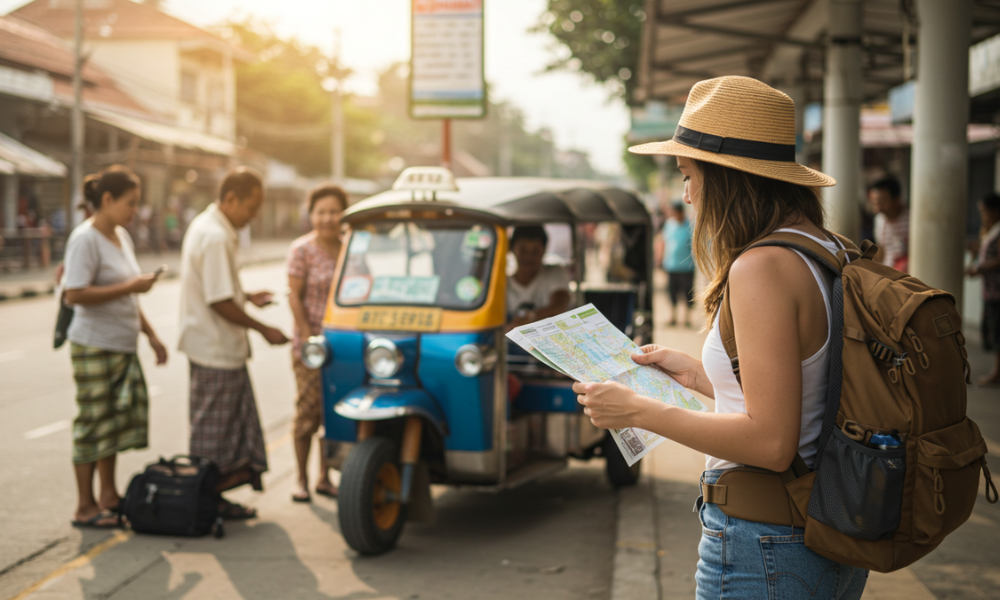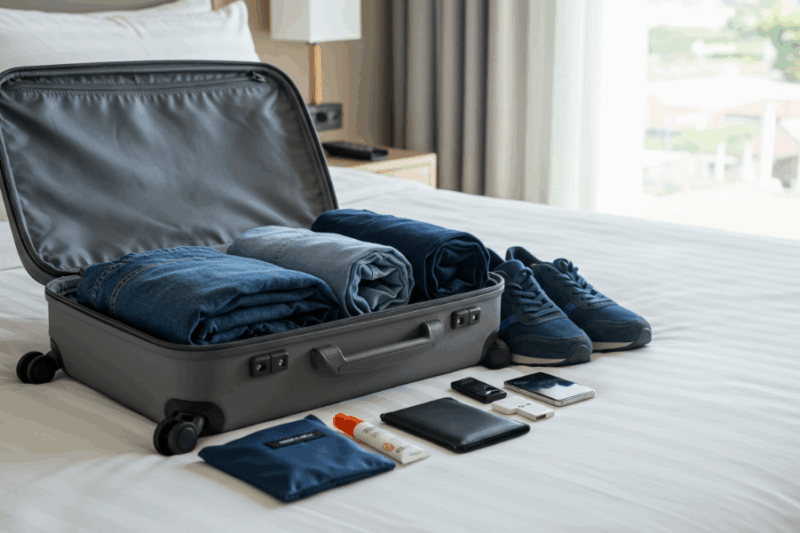Exploring a new country is exciting, but navigating local transport can feel overwhelming for first-time travelers. For minimalist travelers, mastering buses, trains, or tuk-tuks abroad aligns with keeping travel light, affordable, and immersive. This guide offers practical steps for beginners to confidently use local transportation systems, from Bangkok’s Skytrain to Mexico City’s metro, with tips to save money and stay stress-free using just a carry-on. Whether you’re hopping between temples or markets, these strategies ensure smooth, budget-friendly journeys.

Why Local Transport Matters for Minimalist Travelers
Local transport is often the cheapest and most authentic way to explore, costing $0.50–5 per ride compared to taxis ($5–20). It reduces reliance on heavy gear (no need for car rentals) and immerses you in daily life, like sharing a Hanoi cyclo with locals. On my Thailand trip, I saved $10/day using buses and ferries, spending $2–3 instead of $15 on Grab. This guide keeps your travel simple, efficient, and wallet-friendly.
1. Research Transport Options Before You Go
Every destination has unique transport systems—Tokyo’s subways, Chiang Mai’s songthaews, or Lima’s combis. Spend 30 minutes pre-trip researching options via travel blogs, X posts, or sites like Rome2Rio. In Kuala Lumpur, I learned the LRT ($0.50–1/ride) was ideal for Batu Caves, saving $5 over taxis. Note key routes, fares, and operating hours (e.g., Bangkok’s BTS runs 6 AM–midnight). Download offline apps like Maps.me or Citymapper (free) for routes and schedules. How to Do It: Search “[city] public transport guide” on Google or X. Check official transit websites (e.g., MRT Singapore). Save screenshots of maps or timetables.
Why It Works: Prepares you for unfamiliar systems, reducing stress.
Time: 30 minutes pre-trip.
2. Use Transport Apps and Offline Maps
Smartphone apps simplify navigation, especially in language barrier-heavy areas. Moovit (free) offers real-time bus and train schedules in cities like Jakarta, while Grab (Southeast Asia) books motorbike taxis ($2–5). In Hanoi, I used Google Maps offline to find bus stops for Hoan Kiem Lake ($0.30/ride). Download city-specific apps (e.g., Seoul’s KakaoMetro) and offline language packs for Google Translate to read signs or ask directions.
How to Do It: Download Moovit, Maps.me, and local apps before travel. Pre-load city maps and translation packs. Carry a portable charger ($15–30) for phone power.
Why It Works: Provides real-time guidance without Wi-Fi, keeping your kit light (just a phone).
Cost: Free apps, $5–10 for local SIM (30GB/month).
3. Learn Basic Local Phrases
Knowing a few transport-related phrases bridges communication gaps. In Thailand, I used “pai nai” (where are you going?) to confirm songthaew routes ($0.50/ride). Learn terms for “bus stop,” “ticket,” or “how much?” (e.g., “cuanto cuesta” in Spanish). In Japan, “eki wa doko desu ka?” (where’s the station?) helped me find Tokyo’s metro. Write phrases in a pocket notebook ($3) or use Google Translate’s audio feature.
How to Do It: Memorize 5–10 phrases via Duolingo (free) or YouTube. Practice asking for directions or fares. Save phrases digitally or in a notebook.
Why It Works: Eases interactions with drivers or ticket staff, showing respect.
Time: 10 minutes/day for a week pre-trip.
4. Buy Tickets or Transport Cards Smartly
Many cities use reloadable transport cards, like Singapore’s EZ-Link ($5 card, $1–2/ride) or Seoul’s T-money ($4 card). These save time and money versus single tickets. In Bangkok, I bought a Rabbit Card ($5) for BTS rides ($1–2), avoiding ticket queues. Research where to buy cards (airports, stations) and top-up locations (convenience stores like 7-Eleven). For buses or ferries, carry small cash ($0.50–2 in local currency) as many don’t accept cards. How to Do It: Check transit websites for card info. Buy at arrival (e.g., airport kiosks). Keep $5–20 cash in small bills for buses or rural routes.
Why It Works: Streamlines fares, saves $0.10–0.50/ride, and reduces ticket stress.
Cost: $5–10 for cards, $10–20 for fares/week.
5. Observe Local Transport Etiquette
Each culture has unspoken transport rules. In Japan, I noticed passengers queue silently for trains and avoid phone calls. In Mexico City, women-only metro cars ensure safety during rush hours. Avoid eating, loud talking, or blocking doors, as I saw frowned upon in Singapore’s MRT. Watch locals to learn—e.g., offering seats to elders in Thailand’s buses. Dress modestly (scarf, $5) for conservative areas like rural Cambodia. How to Do It: Observe passengers’ behavior on your first ride. Follow signs (e.g., “No Food” on trains). Ask hostel staff about local norms.
Why It Works: Prevents awkwardness and respects cultural norms.
Time: 5 minutes observing/ride.
6. Start with Short, Simple Routes
Ease into local transport with short trips to build confidence. In Siem Reap, I took a tuk-tuk ($2) to Pub Street before trying buses to Angkor Wat ($1). Practice using apps or cards on low-stakes routes, like a city-center loop. In Seoul, I rode the subway one stop to Myeongdong ($1) to master T-money before longer trips. Note landmarks or station names to avoid getting lost. How to Do It: Pick a nearby destination (e.g., market, park). Use apps to plan a 1–2 stop route. Carry a notebook ($3) to jot down key stops.
Why It Works: Builds familiarity with systems, reducing anxiety.
Time: 10–20 minutes for first ride.
7. Ask for Help When Needed
Locals, station staff, or fellow travelers are often happy to assist. In Lima, a bus driver helped me find the right combi ($0.50) to Miraflores when I showed a map on my phone. Hostels or cafes are great places to ask about routes—my Hanoi hostel mapped out a bus to the Old Quarter ($0.30). Use gestures, translation apps, or simple phrases if language barriers arise. How to Do It: Approach staff or locals with a smile, saying “help?” or using Google Translate. Show maps or destination photos on your phone.
Why It Works: Leverages local knowledge, saving time and stress.
Cost: Free.
Minimalist Travel Tips
- Pack Light: Carry a 20–30L backpack ($50, e.g., Osprey Daylite) with a phone, notebook ($3), scarf ($5), and small cash. Fits carry-on limits (22x14x9 inches).
- Budget Wisely: Transport costs $1–5/day, keeping total daily expenses at $15–30 (food $5–10, hostel $5–15). Local SIMs ($5–10/month) save on data.
- Stay Prepared: Download offline maps and apps pre-trip. Carry a portable charger ($15–30) and $10–20 in local currency for fares.
- Cultural Respect: Learn greetings (e.g., “salamat” in Filipino) and dress modestly for buses or ferries in conservative areas.
- Safety First: Keep valuables secure (money belt, $10) on crowded transport. Check X for recent safety tips (e.g., “[city] bus safety”).
- Plan Ahead: Note peak hours (7–9 AM, 5–7 PM) to avoid crowds. Save key routes in apps for quick access.
Why This Guide Works
Navigating local transport is a skill that unlocks affordable, authentic travel. These beginner-friendly steps helped me save $50/week in Thailand, using $2/day buses instead of $10/day taxis, while blending into local life. They require minimal gear (phone, notebook, cash) and align with minimalist principles—less clutter, more freedom. From Tokyo’s trains to Phnom Penh’s tuk-tuks, you’ll move with confidence and ease.



